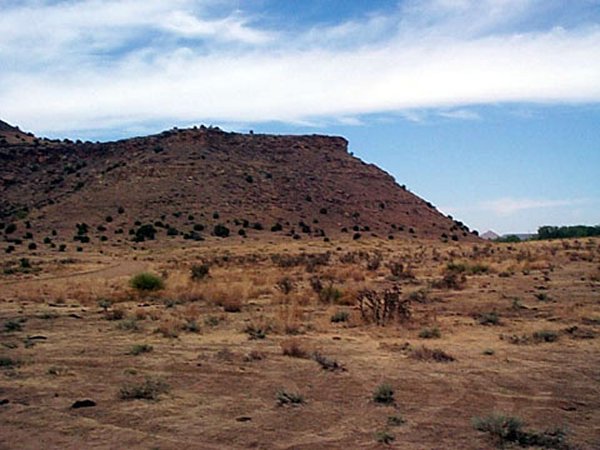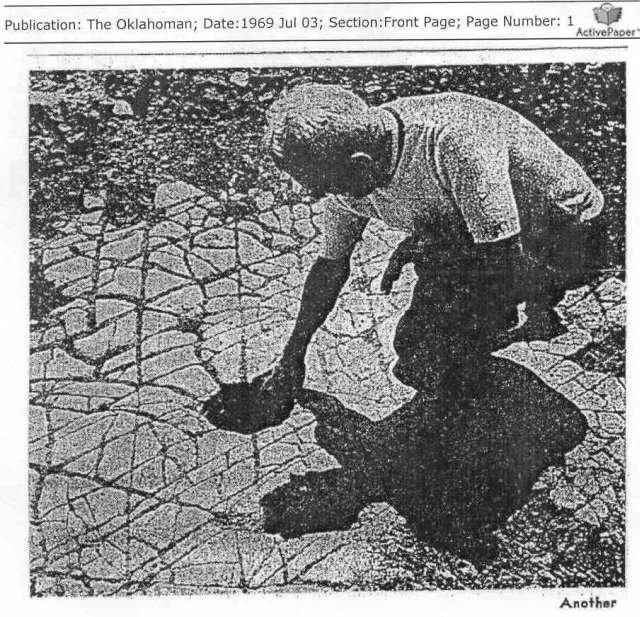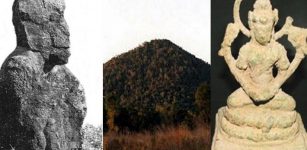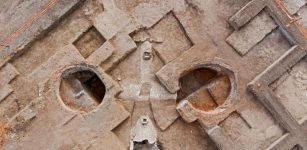Oklahoma’s Ancient Mosaic Floor With Mysterious “Post Holes” Could Re-Write History Of North America
MessageToEagle.com – Every now and then archaeologists stumble upon something that cannot be easily explained.
This happened back in 1969 when archaeologists found Oklahoma’s enigmatic mosaic floor with mysterious post holes. Soon after the discovery a heated scientific debated broke out. Was the structure man-made or a natural formation? How old was the site?
Some speculated it could be as old as 200,000 years.
A couple of archaeologists were convinced the tile floor was definitely man-made. But if, so who created it? Was Oklahoma inhabited by an advanced ancient civilization at that time?
Archaeologist Unearth Mysterious Tile Floor
Unfortunately, there are no good images of the tile floor. There was however one image that appeared in “The Oklahoman” on July 3, 1969. The newspaper wrote the following: ”
On June 27, 1969, workmen leveling a rock shelf at 122nd Street on the Broadway Extension between Edmond (population 68,315) and Oklahoma City uncovered a rock formation that caused a great deal of controversy among investigating authorities.”

“To the layman, the site looked like an inlaid mosaic floor. It apparently looked very much like someone’s floor to some of the experts, as well.”
“‘I am sure this was man-made because the stones are placed in perfect sets of parallel lines which intersect to form a diamond shape, all pointing to the east,’ said Durwood Pate, an Oklahoma City geologist who studied the site.
‘We found post holes which measure a perfect two rods from the other two.
The top of the stone is very smooth, and if you lift one of them, you will find it is very jagged, which indicates wear on the surface. Everything is too well-placed to be a natural formation.'”
“Dr. Robert Bell, an archaeologist from the University of Oklahoma, expressed his opinion that the find was a natural formation. Dr. Bell said that he could see no evidence of any mortaring substance. But Pate, on the other hand, was able to distinguish some kind of mud between each stone.”
“Delbert Smith, a geologist, president of the Oklahoma Seismograph Company, said the formation, which was discovered about three feet (0.9 meters) beneath the surface, appeared to cover several thousand square feet.”
“The Tulsa World quoted Smith as saying: ‘There is no question about it. It has been laid there, but I have no idea by whom.'”
According to the newspaper, Delbert Smith, president of the Oklahoma Siesmograph Co. and past president of the Oklahoma City Geophysical Society, and Durwood Pate, independent petroleum geologist, traveled to the site to study the area and take samples.
“I am satisfied that it is not a natural earth formation, and that it is man made,” Smith later said.
Smith and Pate took a core sample to make a microscopic investigation of the material in hopes of deciding what it is.
Second Mysterious Hole Discovered
Some days later, on July 1, The Oklahoman reported about the discovery of a second hole through the rock strata. Measurement revealed the two holes to be exactly 16 1/2 feet apart or precisely one rod. According to Pate the rock is Permian limestone laced with quartz grains.
Ancient Stone Hammer Of Unknown Origin Discovered
Two days later, on July 3, The Oklahoman continued its coverage and reported archaeologists discovered an ancient stone hammer at the site.

The newspaper wrote:
“The mystery of a dolomitic limestone formation unearthed between Oklahoma City and Edmond was compounded Wednesday by the discovery of an object on the site which resembles a stone hammer. Geologists who have focused their attention on the unusual formation …. were at a loss to explain the origin of either the formation or the artifact. John M. Ware, an Oklahoma City geologist, said, ‘It simply can’t be explained within the field of geology – we need an archaeologist to give a final opinion.’ ….
However, its age and origin may remain a mystery unless an archaeologist can be persuaded to take on the project soon. Within 20 days, construction workers will continue their job of digging out the area to begin building on a food stuffs warehouse ….
Another intriguing point about the rock is that is contains marine deposits, indicating that it was laid down in the ocean …. Pate said that the formation, 100 feet by 60 feet in area, is rapidly becoming a tourist attraction. ‘People are flocking there and taking pieces of the rock away,’ he said. ‘We need to preserve it until something can be done about determining its origin.'”

It is interesting to note that in 1912, that is 57 years before the discovery of the Oklahoma tile floor, two employees of the Municipal Electric Plant of Thomas, Oklahoma, were shoveling coal into the plant furnaces, using fuel which had been mined near neighboring Wilberton. One chunk of coal was too large to handle, so the workmen took a sledge hammer to it.
Once it broke open, however, the workmen found that the chunk contained an iron pot, and upon its removal, the two coal halves bore the “mold” of the pot in its interiors.
See also:
10 Great Ancient Mysteries Of North America
Most Famous Of The Ancient Earthworks Of North America – Best Seen From The Air
People Who Predated Clovis Culture And Were Present In America Earlier Than Previously Thought
Both employees signed affidavits testifying to the authenticity of the discovery, and the iron pot was subsequently examined by several experts – every one of which was most reluctant to comment on the pot, and the circumstances surrounding its discovery.
This was most understandable, since the object came from coal dated from 300 to 325 million years.
Unfortunately, the discovery of the ancient mosaic floor in Oklahoma raises more questions than answers. The age of site is not determined. Its creators are undefined and on top of everything, archaeologists did not investigate this intriguing site further.
That is shame really because this discovery could easily re-write the ancient history of North America.
We conclude by saying that so many years after its discovery, there are still no definite answers about the “mosaic floor” found in Edmond, Oklahoma.
© MessageToEagle.com










